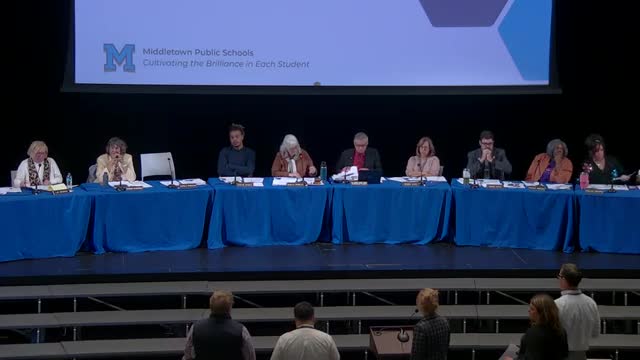District releases mixed academic results; officials outline tutoring, curriculum and assessment steps
October 15, 2025 | Middletown School District, School Districts, Connecticut

This article was created by AI summarizing key points discussed. AI makes mistakes, so for full details and context, please refer to the video of the full meeting. Please report any errors so we can fix them. Report an error »

Middletown administrators reviewed standardized assessment results and next steps at the Oct. 14 board meeting, highlighting areas of growth and ongoing gaps between high‑needs students and their peers.
Paul Griswold, director of assessment and curriculum, framed the district’s reporting by explaining the difference between achievement (proficiency/performance index) and growth (percentage of a student’s year‑to‑year growth target achieved on Smarter Balanced). He noted the state weights growth heavily in its accountability framework and reminded the board that growth is reported for grades 4–8 on SBAC.
Math: District leaders said several elementary schools — Farm Hill, Moody, Spencer and Wesley — met growth goals in fourth grade. The district reported pressure points including disparity between high‑needs and non‑high‑needs students and higher‑than‑projected athletic and staffing costs that affect resources. The administration said it would continue professional learning, use interim assessment blocks and sustain targeted supports in classrooms.
ELA: Officials described a modest decline in some ELA measures after the first year of HMH Into Reading implementation, a pattern the district said can occur during program rollouts. District staff said this year’s priorities include continued HMH implementation, science of reading professional learning for coaches and teachers, and a move from unit assessments to weekly formative checks to provide more timely data for instruction.
High school & SAT: The district noted a steady pattern in SAT college‑and‑career readiness benchmarks across several recent years and described targeted supports such as PSAT/SAT practice, embedded SAT preparation activities and no‑red‑ink writing practice. Administrators pointed to improved AP outcomes in several courses (including AP Spanish Language and AP U.S. History) and said AP participation has shifted somewhat as the district expanded early‑college and CTE opportunities.
Science (NGSS): The district said NGSS assessment cycles operate on multi‑year rotations and acknowledged the assessment’s cohort structure makes long‑term trend lines less direct. The district has implemented interim science blocks and is emphasizing inquiry‑based instruction (5E model), lab‑based learning and alignment between units and NGSS item formats.
District actions and next steps announced during the presentation included expanded use of interim assessment blocks, continuing math and ELA leadership teams to adapt curriculum, high‑dosage tutoring planned to start in November for targeted students, and professional learning time focused on instructional practices and assessment calibration. Leaders said they will bring more disaggregated, grade‑level data to future board meetings.
Ending: Board members asked for course‑by‑course breakdowns for AP and more longitudinal data for the SAT and SBAC; administrators said they would provide additional downloads and follow‑up analyses.
Paul Griswold, director of assessment and curriculum, framed the district’s reporting by explaining the difference between achievement (proficiency/performance index) and growth (percentage of a student’s year‑to‑year growth target achieved on Smarter Balanced). He noted the state weights growth heavily in its accountability framework and reminded the board that growth is reported for grades 4–8 on SBAC.
Math: District leaders said several elementary schools — Farm Hill, Moody, Spencer and Wesley — met growth goals in fourth grade. The district reported pressure points including disparity between high‑needs and non‑high‑needs students and higher‑than‑projected athletic and staffing costs that affect resources. The administration said it would continue professional learning, use interim assessment blocks and sustain targeted supports in classrooms.
ELA: Officials described a modest decline in some ELA measures after the first year of HMH Into Reading implementation, a pattern the district said can occur during program rollouts. District staff said this year’s priorities include continued HMH implementation, science of reading professional learning for coaches and teachers, and a move from unit assessments to weekly formative checks to provide more timely data for instruction.
High school & SAT: The district noted a steady pattern in SAT college‑and‑career readiness benchmarks across several recent years and described targeted supports such as PSAT/SAT practice, embedded SAT preparation activities and no‑red‑ink writing practice. Administrators pointed to improved AP outcomes in several courses (including AP Spanish Language and AP U.S. History) and said AP participation has shifted somewhat as the district expanded early‑college and CTE opportunities.
Science (NGSS): The district said NGSS assessment cycles operate on multi‑year rotations and acknowledged the assessment’s cohort structure makes long‑term trend lines less direct. The district has implemented interim science blocks and is emphasizing inquiry‑based instruction (5E model), lab‑based learning and alignment between units and NGSS item formats.
District actions and next steps announced during the presentation included expanded use of interim assessment blocks, continuing math and ELA leadership teams to adapt curriculum, high‑dosage tutoring planned to start in November for targeted students, and professional learning time focused on instructional practices and assessment calibration. Leaders said they will bring more disaggregated, grade‑level data to future board meetings.
Ending: Board members asked for course‑by‑course breakdowns for AP and more longitudinal data for the SAT and SBAC; administrators said they would provide additional downloads and follow‑up analyses.
View full meeting
This article is based on a recent meeting—watch the full video and explore the complete transcript for deeper insights into the discussion.
View full meeting
